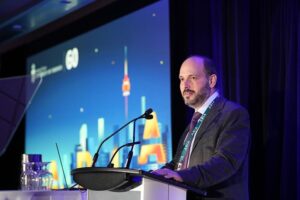- Krystle Hewitt, Department of Computer Science
University of Toronto computer science students and members of the Toronto tech sector came together at the Metro Toronto Convention Centre to share innovative solutions to complex technical challenges. Among these transformative advancements are improving the safe operation of robots in outer space, developing AI-driven triage systems for fast and effective patient dispatch during mass-casualty events and optimizing commercial vehicle logistics to reduce city congestion and support sustainability goals.
The hub of this activity was the Applied Research in Action (ARIA) showcase, an annual event hosted by U of T’s Department of Computer Science on November 14. Tech research and innovation took centre stage, drawing more than 1,700 registrants to engage with over 130 projects spanning sectors such as health care, robotics for manufacturing and logistics, enterprise software, power generation and financial technology.
Partnering with industry leaders to advance tech innovation

Among the presenters was Paan Kugathasan, a student completing a Master of Science in Applied Computing (MScAC), whose internship research with MDA Space — a geointelligence, robotics and satellite technology company and a partner of the Canadian Space Agency — focuses on the safe operation of robots in outer space. His work combines artificial intelligence with physics to improve the collection of safety-critical data about robotic arms that are designed to perform precise and repetitive tasks. This research opens new avenues for delivering more accurate and precise results that could reduce reliance on costly hardware typically used in the process, Kugathasan says.
A longtime space enthusiast, Kugathasan says being able to contribute to space research is especially rewarding.
“I did my bachelor’s at U of T in mechanical engineering and now coming to study AI and being able to combine these two different worlds for space — I couldn’t have written it better,” he added.
The Department of Computer Science has partnered with an extensive selection of leading companies looking to tackle difficult challenges by tapping into the next generation of tech talent.

Investment management company Vanguard has been partnering with the department for the last four years on projects in the domains of AI, natural language processing, large language models and financial portfolio generation work, according to Jithin Pradeep, Vanguard’s head of AI research.
“The combination of professors and U of T students together with our team creates a good understanding of the industry as well as the research domain, helping us put together solutions in a way that’s helping Vanguard move forward and beyond,” said Pradeep. “We like to partner with budding talents and bring them into Vanguard in a way that we can focus on AI innovation.”
Bringing Stories to Life: Animatronics for Education

Sarah Kushner, a PhD student in the department’s Dynamic Graphics Project lab showcased her research to improve classroom learning by combining art and technology for physical storytelling. Her project brings history and science to life through mechanically controlled talking robotic puppets, known as animatronics. She demonstrated a motorized talking bear puppet that students can program to perform cues while narrating a story about environmental issues such as the potential extinction of bees.
Kushner said animatronics give students an opportunity to see themselves as artists, engineers and storytellers.
“This project really tries to show kids they can be creative across disciplines,” Kushner explained.
Bridging Academia and Industry

Eyal de Lara, professor and chair of the Department of Computer Science, noted this year’s ARIA showcase speaks to the strengths of U of T’s computer science community in both applied, industrial research as well as longer-term, curiosity-driven research.
“ARIA showcases the central role that our department and our partner departments at U of T are playing in the growth of the tech industry in Toronto and in Canada,” said de Lara. “Our department continues to innovate, push the research boundaries, and as our students learn, explore research and graduate, they are coming out of the university, and creating a set of new companies that helps to feed the ecosystem.”

Before taking the stage to deliver a keynote talk on Nvidia’s advancements using generative AI for 3D content, Associate Professor Sanja Fidler, who is vice-president of AI research at the company, shared her thoughts on what makes the department of computer science a hub of innovation.
“U of T is really good at these fundamental advances that keep pushing the frontier of technology of AI in general,” said Fidler, noting the pioneering machine learning research of Nobel laureate and University Professor Emeritus Geoffrey Hinton, and colleagues who are building upon these techniques.
Fidler says the academic environment provides students with the opportunity to think ahead and learn how to do “risky research.”
“This environment is very important to lead to some of these breakthroughs, push the fundamentals forward and not worry about pushing products out, deadlines and business impact. It’s really about tackling fundamental problems we want to solve and feeding their curiosity.”
Building a career in tech: lessons from alumni

As for how students should best prepare themselves for their careers as they head into the workforce after their studies?
During a fireside chat at the showcase, alumni Orion Buske, Nick Frosst and Inmar Givoni shared their advice for students and young alumni as they make plans for careers in tech.
For Frosst, it’s not about learning a specific skill based on what people might be saying is the next big thing, but instead about students pursuing their own interests.
“You can’t optimize for what is the most desirable talent,” said Frosst, the co-founder of Cohere, an enterprise-focused large language model company. “What area of computer science should you be working on? Whatever is the thing that you find easiest and most exciting to work on, that’s probably it.”

